According to a recent market analysis report by Grand View Research, the U.S. HVAC market (products and services) is estimated to increase by $9.48 billion between 2022 and 2030, from $17.45B to $26.93B. The residential portion of the U.S. industry represents approximately 40% of the total market.
This growth will be driven largely by the following rising market preferences, applicable to both residential and commercial properties:
- Increased energy efficiency
- Improved air quality
- Enhanced comfort
- Expanded reliance on professional services for new, upgraded and optimized systems
As the demand for energy efficient and wellness-focused solutions continues to rise, it’s more important than ever for both homeowners and HVAC product & service providers to stay up-to-date on the latest trends in HVAC systems and related technologies. Residential consumers who embrace these trends will also need to invest in regular air duct cleaning and HVAC maintenance to ensure consistent comfort and cost savings throughout years of ownership. HVAC service firms, in turn, will be challenged to provide consistent high-quality customer service while competing for a shrinking pool of skilled technicians to meet this growing consumer demand.
In this article, we’ll explore the top 10 HVAC trends shaping the future of the residential market.
Top 10 HVAC Trends Shaping the Home Market
- Energy Efficiency
- Smart Technology
- Improved Air Quality
- Intelligent & Adaptive Systems
- Multi-Zone HVAC Systems
- Adaptation to Extreme Weather Conditions
- Investment in HVAC Upgrades and Maintenance
- Service Automation
- Virtual Repairs to Address the Shortage of Skilled Technicians
- Improved Customer Service
Also see:
- 6 Reasons Ductless Mini-Split ACs are a Game-Changer for Your Home
- How to Create an Allergy-Free Environment in Your Home
- Expert Tips to Lower Your Home’s Heating Bill
- More Recommended HVAC-Related Articles
- Related Topics: HVAC | Energy Efficiency | Home Wellness | Cost Savings | Utilities | Hiring Contractors
1. Energy Efficiency
According to Energy Star, HVAC systems account for approximately half of a home’s energy consumption. As a result, there is growing demand for energy efficient HVAC solutions that significantly reduce energy consumption.
The need for homeowners to reduce their monthly utility bills will be the primary reason new HVAC products and technology are first adopted into households. However, residents experiencing newer HVAC technology will likely soon discover and learn to love other new features.
Variable speed compressors, for example, are more energy efficient due to their precise control of fan speeds. This control, in turn, provides more comfort, as the system can maintain a more consistent room temperature, without experiencing extreme bursts of air or wide temperature swings.
Carrier’s Energy Star Rated Infinity® 24 Heat Pump With Greenspeed® Intelligence
Latest HVAC technologies, such as geothermal heat pumps and solar-powered HVAC systems, are leading the charge in sustainability initiatives. In addition to being eco-friendly, these systems qualify homeowners for energy efficiency tax credits and offer long-term savings on their energy bills.
2. Smart Technology
Statista forecasts that over half of U.S. consumers will adopt smart home technology by 2025, including HVAC systems. Similar to other appliance categories, smart technology has also been revolutionizing the HVAC industry, offering homeowners unprecedented control over their heating and cooling systems.
Smart thermostats with wireless HVAC controls help you manage and optimize energy efficiency and comfort levels easily. This trend is expected to grow as homeowners seek greater control and convenience over their heating and cooling systems. More advanced thermostats have been incorporating automated learning capabilities to optimize energy consumption and comfort more conveniently.

Leading brands of smart thermostats include:
3. Improved Air Quality
Another increasingly popular feature related to HVAC systems is the focus on indoor air quality and its impact on health and wellness.

The Environmental Protection Agency (EPA) reports that indoor pollution levels can be up to five times higher than those outside, which can lead to various health problems, including asthma and allergies. As a result, there is a rising demand for HVAC technologies that improve indoor air quality, such as air purifiers and humidity control systems.
Households with pets are also driving the need for stronger and more effective indoor air quality systems.
Also see:
4. Intelligent & Adaptive Systems
The Internet of Things (IoT) has been revolutionizing how we interact with and control a wide range of household appliances and systems, including HVAC systems.
These devices can also alert homeowners to potential maintenance issues, allowing them to address the problem before it becomes a more significant and costly issue. This advanced method of automated maintenance is also often referred to as proactive or prescriptive maintenance.
Furthermore, IoT devices can help HVAC professionals diagnose and troubleshoot issues more efficiently, such as doing initial assessments remotely, reducing repair times and costs.
Remote sensors are also being used with HVAC and air quality systems to capture more precise data to system controllers to be able to maintain temperatures and air quality more effectively, increasing overall comfort.
5. Multi-Zone HVAC Systems
Multi-zone HVAC systems allow homeowners to control the temperature in different areas of their homes independently. With these systems, homeowners can optimize energy efficiency by heating or cooling only the areas of the home that are in use.
In addition, multi-zone systems offer greater comfort by allowing homeowners to customize the temperature in each zone to individual preferences. A trending example of a popular multi-zone solution is ductless mini-splits, preferred for their many benefits.

Also see:
6. Adaptation to Extreme Weather Conditions
Prolonged extreme weather conditions, such as record heat waves and severe cold fronts, require residential HVAC systems that can quickly adapt to and withstand these protracted circumstances.
The latest HVAC technologies, such as variable-speed compressors and dual-fuel systems, are designed to handle these challenging conditions, while maintaining optimal comfort levels in the home. As more homeowners experience perilous weather conditions, the demand for these technologies will only increase.
Also see:
7. Investment in HVAC Upgrades and Maintenance
As HVAC systems continue to evolve and improve, more customers are opting to upgrade their existing systems with new and innovative technologies. Smart thermostats are just one example.
Many homeowners are investing in high-efficiency HVAC systems, as well as turning to ductless mini-split systems for new home additions, such as ADUs. Mini-splits in particular enable greater flexibility for heating and cooling individual rooms and zones.
Given the increasing awareness and focus on energy usage and air quality, homeowners are quickly learning the importance of keeping their HVAC systems well-maintained and optimized. In other words, poorly maintained systems can lead to poor performance and efficiency, defeating the purpose of the original investment.

The use of geothermal HVAC systems, which harness the earth’s natural energy to heat and cool homes, is also on the rise. These systems are more energy-efficient than traditional HVAC systems and can provide significant cost savings over time.
Also see:
8. Service Automation
Many HVAC businesses are adopting automation to meet the ever-increasing demand for HVAC products and services. There has been a recent uptick in the use of automated scheduling and invoicing systems in the HVAC industry, which has allowed businesses to better manage their field service operations and invoice processing.
Automation can also help improve customer service by providing real-time updates and notifications about appointment times, technician arrivals, and service completion. Through the use of automation, HVAC firms can enhance customer experience while also effectively scaling their businesses.

Image courtesy of Service Titan
Providing efficient and timely service is critical for HVAC service providers as their customers often need them during serious weather conditions, such as extreme cold fronts and heat waves.
9. Virtual Repairs to Address the Shortage of Skilled Technicians
The HVAC industry is facing a significant challenge as the demand for skilled technicians continues to outstrip supply. As consumer demand for HVAC services increases, HVAC companies are finding it challenging to hire and retain skilled technicians due to the low interest in HVAC jobs among the younger generation.
Attracting young and skilled technicians is becoming increasingly important as the existing workforce ages. One solution to this problem is to provide more training opportunities and apprenticeships to attract new talent. HVAC companies also need to offer competitive salaries and benefits to retain their employees.
True to the axiom of “necessity is the mother of invention”, homeowners and HVAC service firms, alike, will also increasingly turn to virtual repairs to mitigate declining rosters of qualified technicians.

Image courtesy of ACHR News
Initial virtual assessments will also help reduce the number of unnecessary in-person visits by technicians in high demand. If desired, older, more experienced workers can transition from field roles into virtual roles that would empower them to share their expertise to a wider population of technicians and customers.
10. Improved Customer Service
In the current cut-throat HVAC industry, excellent customer service is no longer an option but a necessity. Customers expect high-quality service and a positive experience from their HVAC service providers. Additionally, they expect prompt, efficient, and reliable service and are willing to pay a premium.

Besides delivering well-executed installations and service calls, the best HVAC professionals will also need to establish trust with their customer bases to provide credible recommendations on how to take advantage of new innovations within the HVAC industry. Homeowners need to make well-informed decisions based on viable choices that are well-suited for their specific circumstances.
As more homeowners learn to rely on word-of-mouth recommendations, referral threads on local sites like Nextdoor, and dependable review sites, quality HVAC companies will thrive, while disreputable firms will likely fail.
Also see:
What to Expect from the HVAC Industry in the Future
The HVAC industry is changing rapidly. Consumers need to keep up with the latest trends to reap the benefits of new technologies and solutions, while HVAC businesses need these new capabilities to remain competitive. By embracing these trends, HVAC companies can provide better service, and consumers can enjoy more comfortable, energy-efficient, and eco-friendly homes.
While the latest innovations in HVAC can offer many benefits to users, it’s important to remember that proper maintenance and professional installation are key to well-performing systems. It is also essential for consumers to work with licensed and certified HVAC technicians to install new systems and implement upgrades correctly and safely.
About the author
Shelby Bartz is the new Content Editor of Precision Air & Plumbing, a full-service HVAC, plumbing, and home performance contractor operating in Chandler, Arizona. Shelby is a devoted bookworm, but when she isn’t reading, you’ll find her cruising around town with her beloved ginger husky, Maxxy.
Additional HVAC-Related Articles
- Indoor Air Quality Resources
- UV-C Products to Make Your Home Healthier & Virus Free
- Smart Solar Panel Blinds Inspired by Sunflowers
- Want Solar Panels? Here’s What You Need to Know About NEM
- What to Consider Before Purchasing a Solar Panel System for Your Home
- Are Smart Meters Harmful to Your Health?
- 7 Benefits of Maintenance Access Doors for Your Home
| Purgula is reader-supported. When you click on links to other sites from our website, we may earn affiliate commissions, at no cost to you. If you find our content to be helpful, this is an easy way for you to support our mission. Thanks! Learn more. |








Fantastic article! It’s intriguing to observe how these trends are influencing the future of the housing market. The HVAC sector is truly going through some exciting developments. Since indoor air quality can be significantly worse than outdoor air quality, thanks for emphasizing the significance of HVAC systems that improve air quality. Overall, these trends prioritize sustainability and energy efficiency while simultaneously enhancing comfort and convenience. It’s fascinating to observe how the HVAC sector is developing to accommodate homeowners’ shifting wants and promote a greener future.